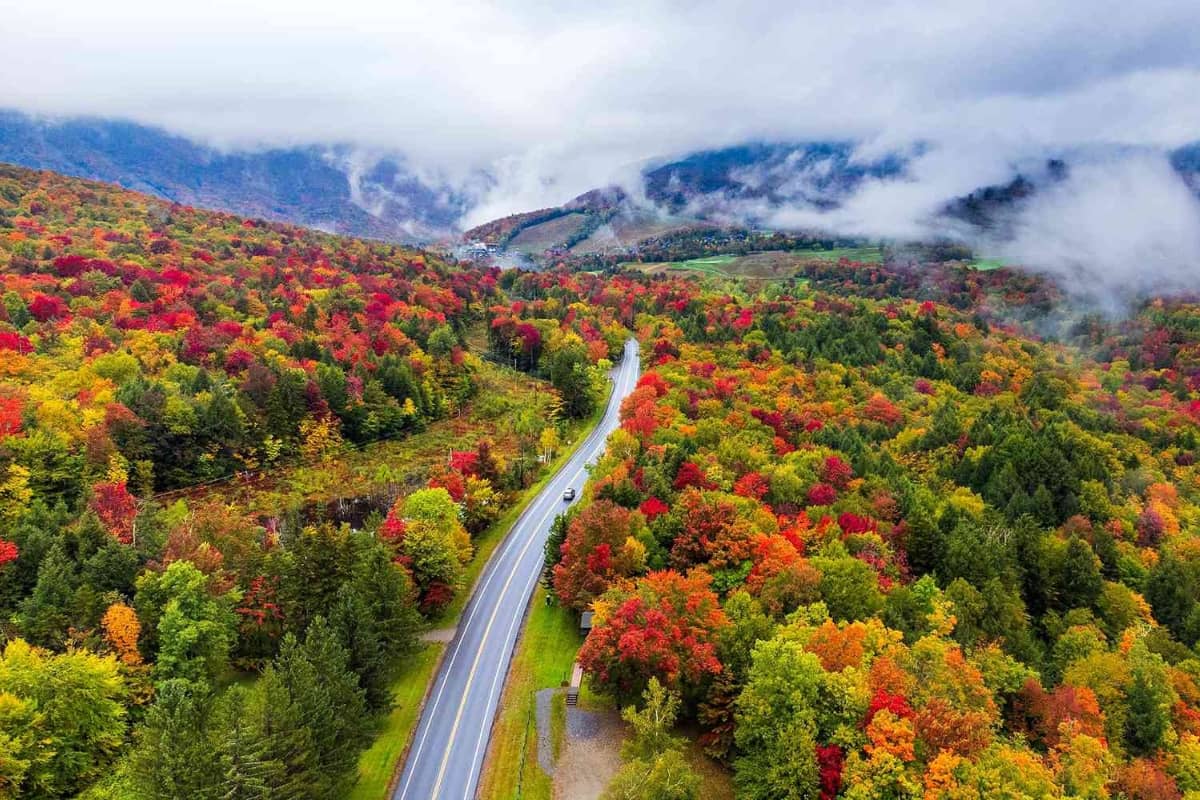The allure of fall in Manchester, Vermont, is undeniable. The town is famed for its spectacular autumn views, from vibrant trees to scenic drives through mountainous landscapes. However, as captivating as the foliage may be, visitors should be aware of several hidden dangers that accompany the experience. The crisp autumn air, colorful leaves, and picturesque surroundings can quickly shift into a more treacherous experience if you’re not cautious. Below, you’ll find a detailed exploration of the six hidden dangers that could await you during your visit to Manchester’s fall foliage.
1. Slippery Roads and Trails
One of the most common yet overlooked risks during the fall foliage season is slippery conditions caused by fallen leaves. When leaves pile up on roads and trails, they can become slick, especially after rain, creating hazardous walking or driving conditions. This is particularly concerning on Manchester’s scenic but steep Skyline Drive, which ascends to the summit of Mount Equinox. The vibrant leaves may entice you to take in the sights, but extra care should be taken as wet leaves can reduce traction, making it easy to slip while hiking or lose control when driving.
Hiking trails, such as the Historic Marble Rail Trail and more challenging routes around Mount Equinox, are especially vulnerable. The risk of injury increases as leaves obscure the ground, hiding potential tripping hazards like rocks, roots, or uneven terrain. Visitors should equip themselves with proper footwear and be cautious, particularly after rainy weather.
2. Unpredictable Weather Conditions
Autumn weather in Vermont can be temperamental, with rapid changes in temperature and sudden storms. Manchester’s higher elevations, such as those along Mount Equinox, experience frequent shifts in weather. One minute you might be enjoying a clear, crisp view, and the next, you could be enveloped in fog or caught in a rainstorm, making it difficult to navigate safely.
Fog, in particular, poses a danger during early morning or late evening hikes and drives, significantly reducing visibility on narrow or winding roads. Visitors driving the popular Route 7 or Skyline Drive must be aware of these sudden weather changes and prepare accordingly by checking weather forecasts and bringing appropriate gear.
3. Wildlife Encounters
Vermont’s forests are home to abundant wildlife, including deer, moose, and bears, and fall is a time of heightened activity for many animals. Drivers on scenic roads such as Route 100, which is one of the state’s most famous foliage drives, should be particularly mindful of animals crossing the road, especially at dawn or dusk.
While spotting wildlife may seem like a delightful addition to your fall adventure, encountering a large animal such as a moose on the road can lead to serious accidents. Deer are also highly active during the fall as it’s their mating season, which increases the likelihood of sudden appearances on trails or highways. Always drive cautiously, particularly in low-light conditions, and hike with awareness of your surroundings.
4. Overcrowding and Limited Emergency Access
The beauty of Manchester during the fall attracts a large number of visitors, which means roads, trails, and tourist hotspots can become highly congested. Popular areas like Mount Equinox, Hildene (the Lincoln family home), and local apple orchards often see a surge in tourists. While the increased foot traffic may seem harmless, overcrowding presents a real danger in emergencies.
Narrow roads and trails become congested, making it difficult for emergency vehicles to reach accident sites. For example, Skyline Drive is a toll road that leads to the top of Mount Equinox. While the views from the summit are breathtaking, the road is steep and narrow, and in the event of an accident, heavy traffic could severely delay help from reaching the scene.
To mitigate this risk, it’s recommended to plan visits during non-peak hours or weekdays. Additionally, consider familiarizing yourself with local emergency numbers and staying in areas where mobile reception is available.
5. Limited Cell Phone Service in Remote Areas
Despite Manchester’s popularity as a fall destination, certain regions, especially around Mount Equinox and remote hiking trails, have limited or no cell phone reception. Visitors often underestimate the challenges this poses if they get lost, injured, or require emergency assistance.
Even well-trodden paths like the Skyline Drive or the Historic Marble Rail Trail can leave visitors disconnected from help. It’s essential to have a backup plan in place, such as notifying someone of your route before venturing out or carrying a GPS device that doesn’t rely on cellular coverage. Additionally, be prepared with physical maps of the area to avoid relying solely on mobile navigation tools.
6. Tick Exposure and Lyme Disease
Though it may seem more like a summer hazard, ticks remain active during the fall and can be found in the tall grass, leaf piles, and wooded areas of Vermont. The state is known for its high incidence of Lyme disease, a potentially serious illness transmitted through tick bites.
Fall foliage enthusiasts often sit in leaf piles or venture through grassy trails without considering the possibility of tick exposure. To protect yourself, wear long sleeves, tuck pants into socks, and apply insect repellent before heading outdoors. After any hike or outdoor activity, conduct a thorough tick check on your body and clothing. Lyme disease can have long-term effects if not caught early, so it’s essential to be proactive in preventing tick bites during your visit to Manchester.
Conclusion
The fall foliage in Manchester, Vermont, is undoubtedly a stunning spectacle, drawing tourists from across the country. However, behind the captivating colors and peaceful landscapes, several hidden dangers lurk, from slippery conditions to unpredictable weather and wildlife encounters. Overcrowding, limited cell service, and the risk of tick exposure further compound the hazards that can turn a serene getaway into a perilous situation.






